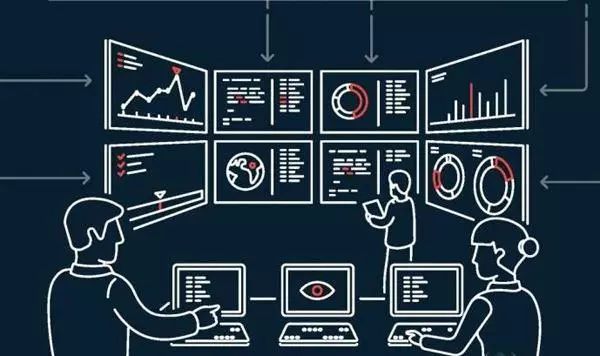Cybersecurity is a dynamic process, mainly reflected in the following two aspects:
The methods of attackers are constantly changing, and attack methods and tools are continuously updated. With the increasing number of devices on the network, various vulnerabilities continue to emerge, providing new breeding grounds for attackers.
Network business is constantly changing; software systems are evolving, and personnel are changing. It is unrealistic and impossible to solve all problems through a single system or solution.
Therefore, cybersecurity requires continuous investment in human resources, material resources, and financial resources, necessitating sustained operations, maintenance, and optimization, leading to the emergence of SOC.

What is a Security Operations Center?


The Security Operations Center, commonly referred to as SOC, adopts a centralized management approach, unifying the management of relevant security products, collecting security information from all network assets, and providing timely reflection of the security status of managed assets through in-depth analysis, statistics, and correlation of collected security events. It detects and locates security risks, identifies various security incidents promptly, and provides handling methods and suggestions to assist administrators in incident analysis, risk analysis, early warning management, and emergency response handling.
Core Capabilities of the Security Operations Center

The SOC platform can collect, filter, format, merge, and store information generated from various heterogeneous data sources, providing capabilities such as pattern matching, risk analysis, and anomaly detection, allowing users to monitor and manage the operational status of the entire network in real-time, assess vulnerabilities of various assets (hosts, servers, IDS, IPS, WAF, etc.), analyze, statistically assess, and correlate various security events, and timely issue warnings to provide rapid response capabilities.

Its core capabilities are as follows:
-
Network Management Capability
The SOC platform can monitor the operational status of various network devices through protocols like SNMP, SSH, Telnet, and alert on operational anomalies. Monitoring functions include:
-
Monitoring device operational status, such as system CPU, memory, system time, and device uptime;
-
Monitoring port information, such as the active status and address changes of each port;
-
Monitoring traffic information, collecting total traffic, total outgoing data volume, total incoming data volume, etc., at the current moment;
-
Automatically discovering network topology, displaying it in a graphical interface, and providing view operations and export functions.
-
Security Asset Management Capability
The SOC platform provides asset information library maintenance capabilities, allowing for the addition, deletion, modification, etc., of asset information, and supports asset retrieval functions. The information of managed device assets can be queried individually or in combination based on conditions such as device IP address, unit of ownership, device type, security domain, and business system.
-
Risk Management Capability
The SOC platform supports risk calculation analysis and presentation based on IS013335 and ISO17799 standards. It allows viewing asset risks from perspectives such as region, business system, and IP address range, providing timely awareness of security events, configuration vulnerabilities, and security loopholes.
-
Work Order Management Capability
The SOC platform achieves rapid closed-loop response to security events through work order management.
After detecting a security event through the incident monitoring center, a new work order is generated manually or automatically by the system, and the relevant responsible person is notified via system alerts or emails for handling. Work order management tracks the entire process after the work order is dispatched, including work order retrieval and re-dispatching.
-
Event Collection and Acquisition Capability
The SOC platform can collect security event information sent from event sources through various methods, including:
-
Reading the log files of event sources through file methods to obtain security-related information;
-
Receiving security events sent from event sources via SNMP Trap and syslog methods;
-
Acquiring security-related information or database operation logs stored in various databases through JDBC, ODBC database interfaces;
-
Receiving events sent from this type of security event server via OPSEC interfaces;
-
Directly forwarding security events to the security event collection system through third-party applications or self-developed agents, in combination with the above methods or standard outputs.
-
Event Processing and Correlation Analysis Capability
The event processing function in the SOC platform is primarily responsible for standardizing, filtering, merging, and centrally storing security events.
The correlation analysis in the SOC platform uses rule-based correlation or asset vulnerability and threat intelligence correlation to conduct real-time statistical analysis of events. When conditions are met, corresponding security response actions are triggered, such as sound alarms, email alerts, SMS alerts, and various other methods.
-
Knowledge Base Management Capability
The knowledge management platform of the SOC provides general knowledge management functions, such as security knowledge base, training, and personnel assessment, and also offers a powerful vulnerability database, event feature database, patch database, security configuration knowledge base, and emergency response knowledge base.
-
Rich Reporting Capability
The SOC platform’s reports provide comprehensive multi-angle presentation capabilities for various security data within the system. For example, asset type distribution, attack event distribution, security alert trends, etc., and provide user-defined and report export capabilities.
-
Third-Party System Integration Capability
The SOC platform’s third-party system integration capability is another foundation for comprehensive assessment of network security. The SOC platform can obtain necessary information from third-party systems or drive third-party systems or devices to perform targeted work through Webservice interfaces or APIs provided by third parties. For example, the SOC platform can drive vulnerability scanning systems to scan specified assets and obtain scanning results through result interfaces, participating in event correlation analysis.

Value of the Security Operations Center


Based on a specific device or system, such as WAF, IDS, IPS, or vulnerability scanning system, network security analysis can be quite scattered, increasing the probability of misjudgments and omissions, requiring a large number of professionals, and making knowledge accumulation difficult, leading to slow emergency responses.
The SOC platform collects various relevant security information and conducts correlation analysis and verification among them, allowing for a multi-angle security analysis and evaluation of network assets. It streamlines the security operations workflow, significantly enhancing the ability to detect and respond to incidents promptly. Additionally, through knowledge accumulation and the improvement of system operations, it continuously strengthens and enhances the network’s security protection capabilities, attack detection, and emergency response capabilities.

Source: Cybersecurity Knowledge Dissemination
Editor: Chen Zhengguo
Reviewer: Sun Dandan

